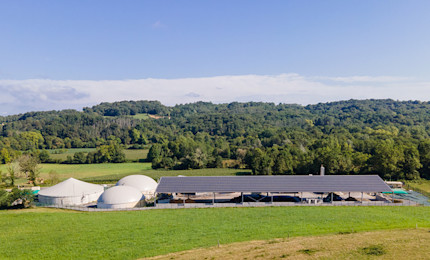Gas emergency 0 800 028 800

Teréga opens up the way to renewable mobility with bioNGV
Our role as an accelerator of energy transition involves us in the development of new gases, such as biomethane, but also support for new uses. Thus biomethane can be exploited as a fuel: BioNGV. This encourages more sustainable mobility with greater respect for the environment, with significant prospects. Especially as those are not its only virtues.
BioNGV: when biomethane enables 100% sustainable travel
When it comes to mobility and fuel, the challenges associated with energy transition, global warming and environmental priorities are considerable. Numerous alternatives to traditional fuels are emerging as part of our search for a sustainable response. They include Natural Gas for Vehicles (NGV) and its renewable version: BioNGV.
BioNGV is biomethane used as a green fuel. This biogas is produced from the fermentation of organic waste sourced from farming, industry or households. Once processed, it can fuel different types of vehicle. In addition, it is produced locally and has an excellent carbon footprint. Indeed, in addition to virtually zero GHG emissions, BioNGV emits neither nitrogen oxides (NOx) nor black smoke.
BioNGV: Teréga supports the emergence of a virtuous economy
Because we are a committed actor in regional development, we encourage the introduction of solutions which make gas a driving force of the future. BioNGV, and consequently biomethane, carry that ambition forward.
Indeed, the biomethane sector provides a solution to reducing greenhouse gases, managing waste and putting farming on a sustainable footing… But also the creation of local jobs and a boost for the region. Looking beyond the technical, economic or regulatory aspects, biomethane and BioNGV have a role to play in consolidating the potential of the regions, thus making them players in a circular, virtuous economy. This global approach is 100% part of our historic and strategic DNA.
Features that drive valuable prospects for the future:
according to the Ademe (French environmental and energy management agency), use as fuel is the most virtuous way of exploiting biomethane;
the development of BioNGV stations is an additional outlet for biomethane production;
a network of filling stations will encourage the development of local production of biogas through methanisation processes;
BioNGV powered transport will help meet the targets set in the Energy Transition for Green Growth Law (LTECV): 15% renewable energy used for transport by 2030.

Dominique MocklyChairman and CEO of TerégaToday, we have to diversify the energy mix in transport, which is still too heavily dependent on oil-derived products. BioNGV is a positive energy source with many possibilities.






